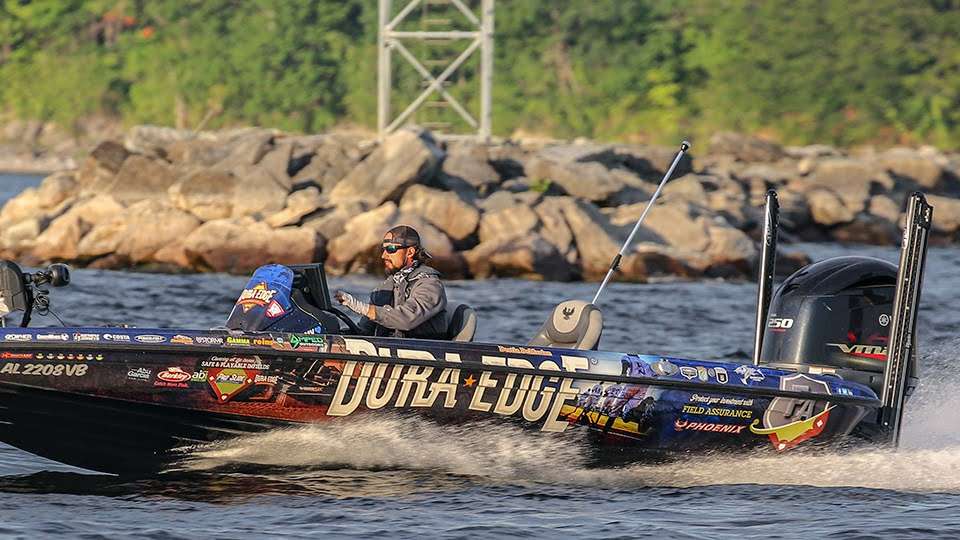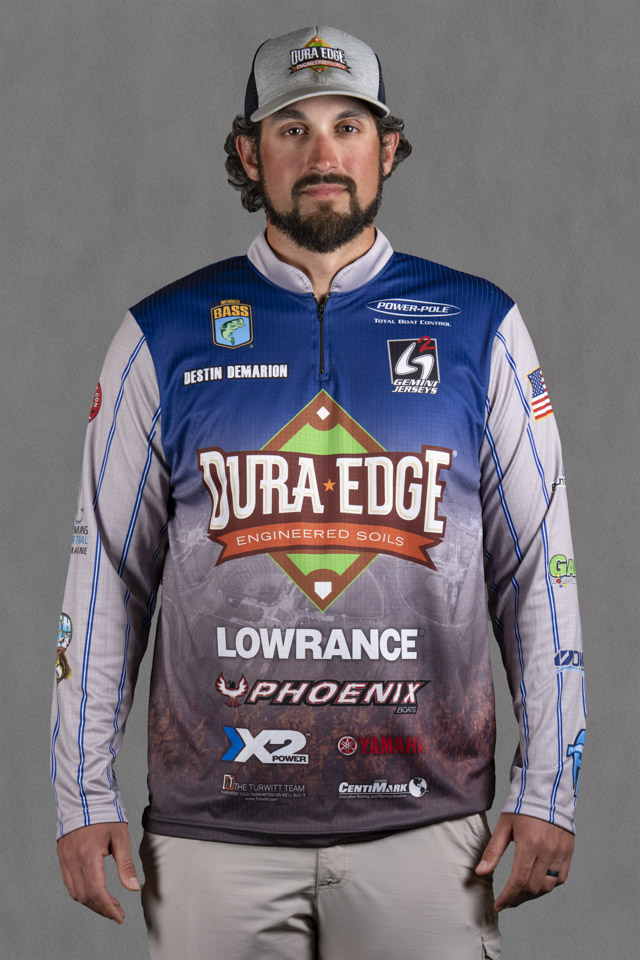
Well, we just wrapped up our New York swing for the 2020 Bassmaster Elite Series season. Expectations are something that can warp our views on how something will go and how it went for us. Although I had confidence that these two events would boost me up a bit in the points race to get to the 2021 Bassmaster Classic, it didn’t end up that way.
I wouldn’t say it was a bad experience by any means, or that I felt I didn’t fish well, because I don’t feel that way. But at the St. Lawrence and Lake Champlain events, I posted a couple middle of the pack finishes. And now we’re heading into the St. Clair event in less than two weeks.
The St. Lawrence River is one of the most picturesque places we go to in the fishing game. With beautiful, clear waters and a multitude of islands dotting this 100-mile playing field, it’s not only easy on the eyes. The river also teems with an absurd amount of smallmouth and largemouth bass. Because it’s so large, I like to break it up into sections. Each section has its own characteristics despite being part of the same river system.
Our event was originally scheduled to be out of Waddington, N.Y., which is far to the east of Clayton where the tournament was held. Clayton is fairly close to the mouth of Lake Ontario, and the lake — which is generally closed in our events — was opened up as competition waters. This added a whole new element to practice and strategy for this event. Generally, Lake Ontario is known for having bigger tournament bags of smallmouth swimming in its often treacherous waters. The tournament did end up being won out there which was mostly expected.
My original plan was to spend most of my time in Lake Ontario because of the way it fishes. It’s largely similar to another Great Lake I do fish quite often — Lake Erie. The river features a lot of current, and fishing current breaks and seams are generally the predominant patterns. In the big lake, fish relate to things like isolated rock piles, shoals and drops not solely dependent on current. Usually this makes them slightly easier to pinpoint in larger concentrations if you are not as experienced or comfortable in the river.
The weather during practice prevented anglers from getting out on the lake for a couple of days due to high winds, so I had about a day to poke around. I found some fish in a couple of areas, but I was not overly excited about how concentrated they were. So I opted to fish the river.
I focused from Cape Vincent to Alexandria Bay in the event after spending most of my practice in these areas. During our event, nearly every section of the river produced. This was just the section where I felt most comfortable. After practice, I felt like I could catch anywhere from 18 to 21 pounds there so I ended up committing to this section.
Like most smallmouth derbies, a drop shot and Ned rig were prime-time players. The drop-shot bait that I solely used was a Berkley Maxscent Flatworm. Having experience fishing for Great Lakes smallmouth, I’ve realized the value of scent over the years. That Maxscent really makes a difference as shown by not only our event but a handful of big events this season on the Great Lakes.
Fishing in and around current meant making precise drifts over high percentage areas. This took some time over practice to dial in as controlling your boat and drifting over specific stretches where these fish will position takes some adjusting with a trolling motor. When the wind wasn’t blowing against the current, I tried to keep the nose of my boat against the current and my bait within close contact to help cut down on snags and detect bites more quickly. This also presents the bait naturally which is important when fishing current anywhere.
The first day of the event I caught a solid bag within the weight range I expected fairly quickly. The second day I caught a small limit quickly and kept hitting isolated “big fish” spots to try and put me over the top. This never came to fruition, and I fell a bit in the standings and missed the weekend cut.
It’s always disappointing to fall a bit short in any event, but the silver lining here was being able to spend some time over the weekend with my family. My wife, daughter and mother-in-law drove up to be there Friday evening, and we got to take the baby to see the water and swim for the first time in the lake. It’s definitely harder to be away from home with a new baby, but video chatting apps have made being on the road better.

For th next stop on our New York swing, we headed to one of my favorite lakes in the country — Lake Champlain. Very much rivaling the St. Lawrence for its scenic views, the lake also rivals St. Lawrence’s amazing fishing.
The question at Lake Champlain is always whether to target largemouth, smallmouth or try and mix both. In the past, when I’ve done best — outside of the spawn — I’ve always targeted a mixed bag. During practice I really focused on splitting my day fishing for both species. That doesn’t necessarily mean I would completely shift where I was on the lake much, but I’d switch tactics.
Largemouth, by nature, are more homebodies. They like to find some cover or structure and just hang out most of the time. Smallmouth are much more nomadic. Depending on the forage, smallmouth will swim miles in a day just chasing bait.
Like most of the field, I focused on the northern end of Lake Champlain. Similar to the St. Lawrence, I like to break up Champlain into sections — upper, middle and south. I almost always focus on the northern end of the lake, which by itself, is bigger than a lot of places we fish.
There is tons of habitat that suit both largemouth and smallmouth, and it seems like more and more big events are won in this section of lake now. We had some changing weather conditions during practice. Multiple fronts came through with changing wind direction before things calmed down for the beginning of our event. In my experience, these changing weather conditions seem to affect smallmouth more than the largemouth, so most of my tournament was focused on catching largemouth.
Catching fish, like most years, was never an issue for me or most of the competitors. The lake has an incredibly healthy population of fish up into the 3-pound class with plenty of bigger ones as well. A lot of the field spread out in this vast fishery which also made it even more fun. Where I caught a majority of my fish, I would never see another boat which is why I love Champlain so much.
You can fish whatever way that you want in just about any place you want and have the potential to do well. The weights for this event were incredible. Honestly, they were much higher than most events at this time of year and a lot higher than I expected.
Day 1 I caught what I thought would be a decent bag, but I was definitely surprised at the scales. I knew I needed to step it up and catch around 18 pounds on Day 2 to make the cut. I really didn’t have to go far. I started catching them in my best largemouth area and was culling for the first few hours up to 17-plus pounds. I then ran some isolated spots to try and catch a kicker or two, but I never put anything else in the boat before heading back to my original area.
Next I stopped at a couple of smallmouth spots where I had culled the day prior and caught one at more than 3-1/2 pounds to make a little cull towards the end of the day. With the weights so stacked I knew it would be close, and it really was. I missed the cut by 10 ounces. Although it stunk, I was really happy with all of my decisions for the event. When it’s your time, everything falls into place. You don’t lose key fish, and you have opportunities to win. I know what that’s like after having that kind of a season last year in the Bassmaster Eastern Opens.
With less than half the season behind us, there is still plenty of time to achieve my rookie goal of qualifying for the Bassmaster Classic. This has been a tremendous learning experience so far fishing at the highest level of the sport. I feel like I’m starting to settle in now after the back-to-back events without a long hiatus, and thankfully we won’t have to wait too much longer to tackle Lake St. Clair either.
On a side note, as I talked about in my last column, I work with DuraEdge Products which manufactures infield mix for baseball and softball fields across the world. Essentially, we’re the dirt guys. Being part of the sports turf industry I wanted to ask for your thoughts and prayers for someone I knew. Cody James Bryant was the head groundskeeper for the Hickory Crawdads in North Carolina, the single-A affiliate of the Texas Rangers. I had the pleasure of taking him fishing last season on Lake Norman. He was a good person, very good at what he did, and he had a great personality. Cody passed recently after a falling accident. He was a young man, taken well before his time. Please keep his family and friends in your prayers. You can support Cody’s family here.


